Abstract
The early stimulation in infants during their first years of life is crucial to improve psychomotor skills and development. The present study proposes to apply the program of early stimulation by physiotherapeutic focusing in children from 0 to 3 years old at the Yacucalle Children's Center.” From the Ibarra canton, Imbabura province. The research had a qualitative-quantitative approach, with a descriptive and field scope, the design was quasi-experimental, longitudinal. The results were obtained using the Nelson Ortiz Abbreviated Scale and the UNICEF Early Stimulation Program, applied to 35 children, and evaluating the changes caused before and after the intervention through the use of the third level of the Kirkpatrick Scale. The obtained data indicate that the predominance of the masculine gender between 25 and 36 months; before the intervention, the evaluation of children prevailed in the middle level and some were located in the alert level; after the application of the program, the majority escalated to higher levels, being represented in the medium high level and a small minority maintained the level alert, depending mainly on the area of audition and language. Based on the transition of the results, it can be affirmed that the application of the program allowed to modify the output effectively with regard to the input of the children, reaching effectiveness indices that placed in the numerical range of the environment they are evaluated as optimal and upward respectively.
Keywords: Children's centerearly stimulationpsychomotor development
Introduction
Offering stimuli to a young child can be as old as the creation of humanity, since the stimuli in this area are related to those actions that produce an impact on the human being, originating in him a response, coming from different areas, which can be external or internal and of a physical or psychological nature. The child's relationship with the stimuli in the environment must be strictly exchanged, which is why strict planning will provide better results than leaving it to spontaneity. This is how early stimulation programs came about, for the first time in the United States in the middle of the 20th century. At first, they were applied to children with some kind of disorder, but, upon seeing the enormous progress that the little ones were making thanks to these methods, it was decided to carry out the same techniques by applying them to healthy children, in order to develop their capacities to the maximum and to expand their possibilities in future learning (Rincón, 2019).
As a discipline, early stimulation is a relatively recent model of intervention. Today, thanks to the multitude of research and advances in the field of behavioral, neurobiological and social sciences, there is a certain consensus and awareness of the importance of applying early stimulation programs to the child population, however, in some countries there is still a lack of knowledge on the subject and it is not given due importance, especially if we consider that early stimulation, is a work in which the family, community, health personnel and educators must be linked, assuming that the learning process begins in the heart of the home and later the child grows and needs educational actions that facilitate his or her development. This is an appropriate moment for educators to strengthen their skills and abilities or to detect if there is a problem in the different areas of development, especially in the sensory-motor area (Francisca et al., 2018); (Martínez Moreno & Calet, 2014).
In recent years, neuroscience has advanced thanks to various scientific discoveries on the development, evolution and functioning of the nervous system, which support the importance of early stimulation, emphasizing that in the first years of life it is an important means of facilitating the process of the child's integral development in which learning is favored and in some cases is present, but not in the correct way, so that the best results are not generated (Constante, 2017b).
Problem Statement
Currently in Ecuador there are two major projects provided by the National Government, are aimed at children from zero to three years of age, one of them is through the Comprehensive Centers for Good Living (CIBV) and the other through the program Growing Up with Our Children (CNH), the latter is a free service that consists of a family coordinator visiting homes and prepare families in early education and health issues, through demonstration actions (Social, 2019). In the City of Ibarra, Children's Centers for Good Living (CIBV) were built, which have adequate spaces and professional nurseries for the attention and care of children. However, there are no professional physiotherapists to perform periodic evaluations to identify deficiencies in the development of infants, and implement programs with physiotherapeutic approaches to early stimulation in different areas, taking into account that children are different from each other and so is their ability to learn and develop.
Early stimulation provides children with situations that invite them to learn; therefore the great importance of the stimuli received at a very early age; studies show that, although genetics has great influence on development, it is the stimulation received that determines the capacity of mastery of skills of each human being.
Research Questions
What is the relationship between Food Security, food availability and the level of education of families in rural areas of the Provinces of Imbabura and Carchi - Ecuador, 2019?
Purpose of the Study
In order to evaluate the results of the implementation of an early stimulation program at the Centro Infantil del Buen Vivir "Yacucalle" in the Province of Imbabura. The family was incorporated as stimulation agents, starting with the evaluation of the psychomotor development of the children, before and after the implementation of the early stimulation program.
Research Methods
The present research has a quali-quantitative, descriptive, observational, evaluative and field approach, carried out at the Centro Infantil del Buen Vivir "Yacucalle"; children were intervened to whom an early stimulation program was applied by physiotherapeutic approach, deliberately manipulating the psychomotor development variable, in order to observe its effect after the intervention. The research collected data in different periods, to make inferences regarding the change, its determinants and consequences through the observation and analysis of the activities that the children participated, knowing the psychomotor characteristics of each child on the project. The collection and analysis of numerical data that were obtained from the assessment scale and detailed each of the variables of the study, through observation, which allowed to explain the changes.
The observational, bibliographic and statistical methods were those used in the study, considering children from the Centro Infantil del Buen Vivir (CIBV) "Yacucalle" in the Province of Imbabura, who had the informed consent of their parents and attended on a permanent basis during the research process and excluding those with any neurological impairment or disability that did not allow them to be part of the research.
The inclusion criteria were families who voluntarily agree to participate in the study and who live permanently in the study places for at least 5 years. The exclusion criteria were people who do not live permanently in the study places.
Techniques and instruments for collecting information
Nelson Ortiz's short scale: it was used for the evaluation, because of its correspondence with the activities applied in the program used to evaluate: gross motor, fine motor, hearing and language, and social personal, depending on the chronological age, each activity has the value of one point, the evaluation ends when the child presents 3 consecutive zeros.
Excel document for the tabulation: a database was used in the Microsoft Excel program, which allowed the tabulation of evaluation results before and after the intervention.
Kirkpatrick's scale evaluation model: this factorial scale has four levels, for the evaluation of the results we rely on the third level of the model, the level of effectiveness, which made it possible to apply what was learned in the performance of the participating children, also called "transfer of learning".
Population
All the children (50) who attended to the Children's Center of Good Living (CIBV) "Yacucalle" in the Province of Imbabura.
Sample
The sample consisted of 35 children who has the characteristics for be part of the study.
Findings
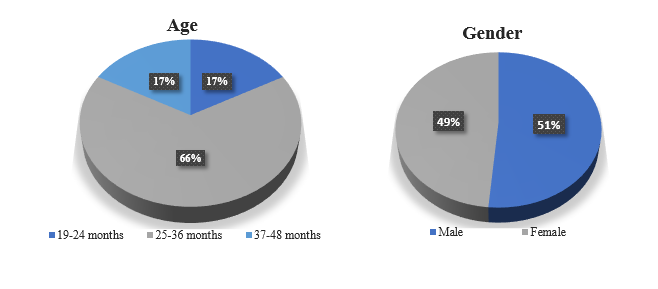
The sample obtained at the CIBV "Yacucalle", has thirty-five children from nineteen to forty-eight months, ages conducive to the application of the early stimulation program; Figure
The data obtained shows a minimal prevalence of the masculine gender over the feminine one, a result that corresponds to investigations carried out in some of the CIBVs in Zone 4, in cantons such as: Portoviejo, Rocafuerte and parishes such as Canoa, Jama and Pedernales (Ecuador, 2020) In In the Sierra region, in cities such as Quito and Cuenca, some gender characterization studies have been carried out in the CIBVs and they also report a majority of the male sex. Everything that differs with data obtained from the official website of the National Institute of Statistics and Censuses INEC, which indicate that of the total of 139,721 inhabitants of the city of Ibarra, 52% correspond to the female gender. Regarding the age variable, most children are aged between twenty-five to thirty-six months, this result is similar to that of research carried out at the Technical University of the North that shows a predominance of children in this age group in children's centers (Física Médica, 2015).
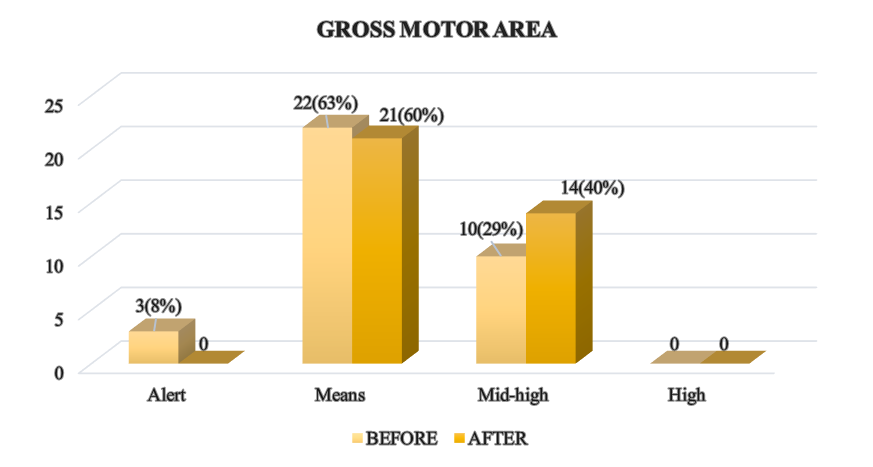
Figure
We can affirm that the children who participated in the research obtained positive results in the gross motor area, by enhancing their psychomotor development, since 9% of the sample that was at the alert level, managed to modify their abilities, climbing medium level; Likewise, the percentage of children evaluated at the upper middle level increased from 28% to 40% after applying the early stimulation program. Although it is true that none of the children managed to achieve the quantitative evaluation of the high level in their psychomotor development, from a qualitative point of view, changes were generated in the children's aptitudes and capacities to carry out some activities, such as: walking in tiptoe, standing on one foot, throwing and catching the ball, and walking in a straight line.
This result agrees with an investigation carried out in Quito, in the Child Development Center “New Horizons” in which, after the application of an early stimulation program, the abilities of the majority of children in gross motor skills were enhanced, that is, if they occur the appropriate stimuli children will be able to improve their motor skills (Zamora, 2016).
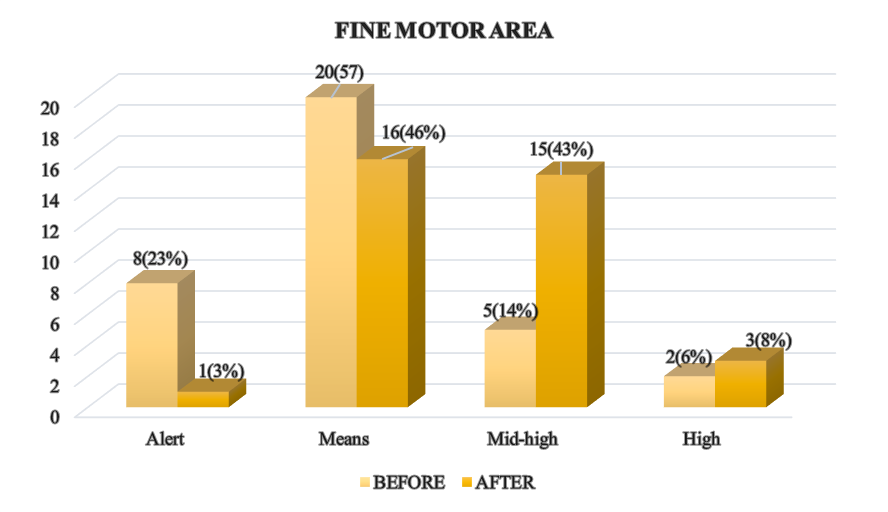
Regarding the fine motor area, it can be seen that, at the beginning of the investigation, eight children were evaluated at the alert level, twenty in the middle, and only two children at high level, after applying the intervention, the results were favorably modified, only one child remained at the alert level, three children reached the high level and the rest obtained evaluations between the medium and medium high levels, all of which is reflected in Figure
In the present study, the daily and constant application of stimuli, made the children improve their fine motor ability, during the application of the program, greater attention was paid to the 8 children who were at the alert level, as a result it was obtained that, thanks to the collaboration between teachers, parents and mainly to the quality of the stimuli given, seven children improved their fine motor skills and finished in the medium level; Although the results were positive, one of the children continued at the alert level, the main reason being, the child's absences from the children's center and especially the lack of cooperation of the stimulating agents.
The results obtained in the CIBV “Yacucalle” express the importance of the application of the program and demonstrate the benefits of early stimulation. Similar results were found in a study carried out in Guayaquil, which indicates the influence of early stimulation on psychomotor development in boys and girls of 1 and 2 years. He affirms that the more stimulation we encourage in the child, the greater his / her performance will be in the educational field, by developing fine motor skills. In order to generate a change in the psychomotor skills of children, the participation of parents is of great importance, since they are the main stimulation agents (Constante, 2017a).
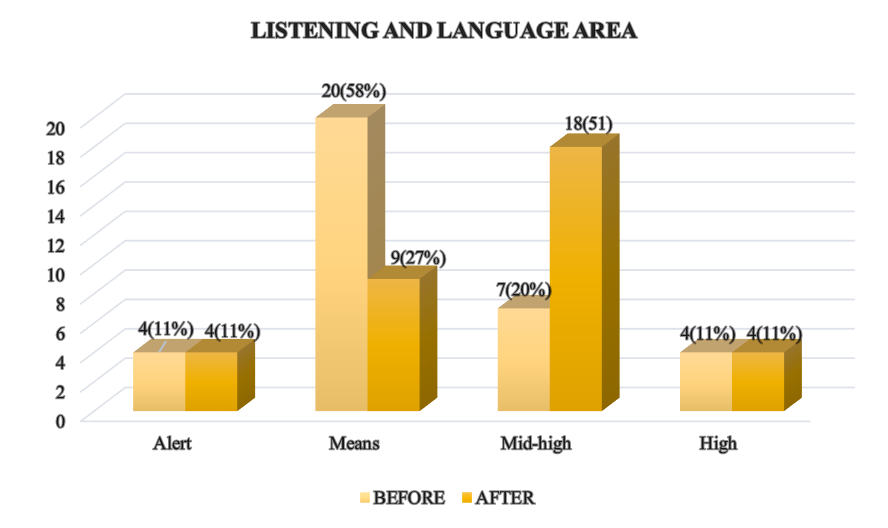
In the area of hearing and language, shown in Figure
The results show the evident enhancement of the psychomotor development of the children when applying the program, since it was possible to modify a significant number of subjects from the medium to the high medium level, meaning that two children also managed to go from the alert scale to medium and vice versa, which we consider as a consequence of the fact that the evaluation instrument used assesses the psychomotor activities of infants depending on their age, some participants who were at the alert level managed to enhance their skills, however, two children who were initially at the level medium, in the second evaluation they were at the alert level, since despite the change in their age, they only showed abilities to start activities that, according to the Nelson Ortiz scale, they had to carry out, such as: describing a drawing, counting fingers, expressing opinions, this result is a consequence of the way parents communicate with their child, the majority do so through diminutives, that is, they do not speak to them using appropriate language, this great error has a considerable impact on the language of children, for this reason the level of alert maintains the number of children, however the program managed optimize the skills of 63% of children at the end of the study.
A publication in Guayaquil evaluated the before and after of the similar intervention and indicates a deficit in the area of hearing and language and assumes that it is one of the areas of development that represents the most problems (Constante, 2017a).
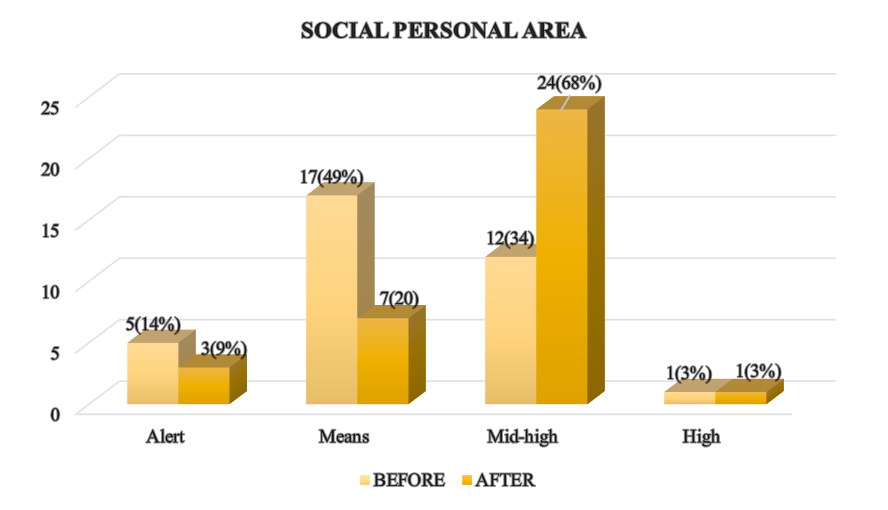
Figure
The change in the results obtained after the intervention period managed to potentiate the psychomotor development of most of the participants. When starting the process, many of the children were impassive to the researcher, due to the lack of familiarity, however, after a few days and thanks to the playful methodology used, they were very interested and became integrated into the program's activities , which contributed to enhancing this area. Thus, 9% of the children evaluated at the alert level, strengthened their abilities and in the subsequent evaluation, they climbed to the medium level; Likewise, there was an increase of 50% in the medium high level, however, 3 children continued in the alert level, which supposes a dysfunctional family environment, referred by the kindergartens and also verified by the observation of the researcher during the training activities stimulating agents and the intervention process itself. It is important to bear in mind that the quality of the stimuli that the infant receives from his parents and the influence of his environment will determine his psychosocial training and, consequently, his psychomotor development. The personal-social area is based on the family, the development of the child with the environment that surrounds it is directly related to the way in which the parents interact with the child (Simón-Benzant, 2015).
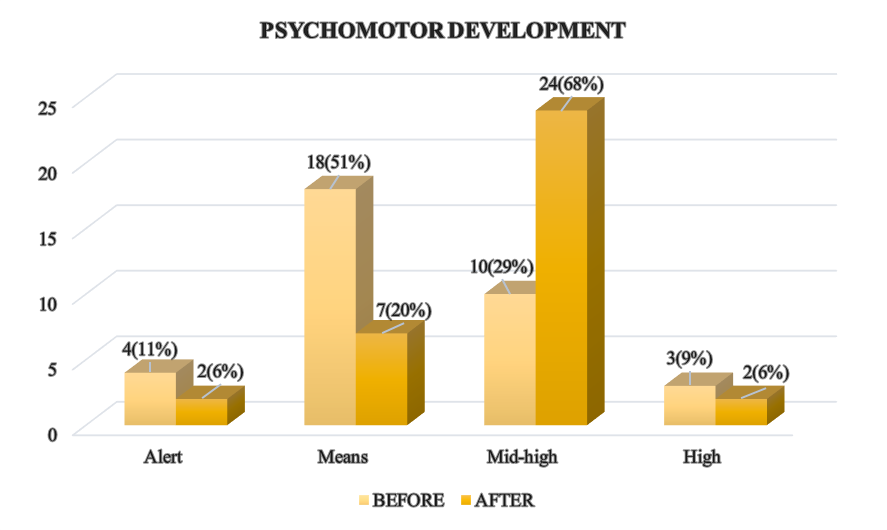
Figure
These data show the transition of results between the evaluations, initially 11% of children were obtained at low levels of development, once the intervention was carried out, it was reduced to 6% and more than half of the participants, corresponding to 74%, fluctuated between the optimal levels of their development. The results show that the application of the early stimulation program was conducive to enhancing the skills of the participants; the exercises applied to the four areas of development promoted skills, especially the attention given to those infants who were initially evaluated at the alert level, which was decisive in obtaining these results; We must highlight the intervention of stimulating agents, a fundamental entity to generate change. In the city of Guayaquil, in the Sueños de David Garden, a study was carried out that determined early stimulation as a fundamental factor in development. From the analysis of the data, very important parameters were obtained that allowed me to better understand how early stimulation is a fundamental factor in the development of social skills in initial children (Aguilar Cordero et al., 2012).
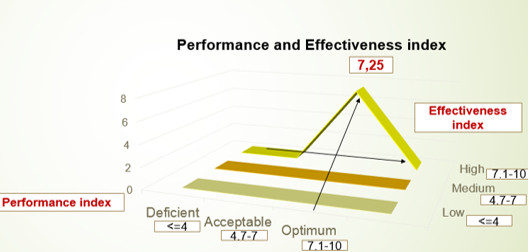
Figure
The use of the simple and integrated Kirkpatrick factorial scale, reflected in Table
When analyzing Figure
Similar results were obtained in an investigation published in 2018, since the stimulation program designed and executed was effective, since it allowed stimulated children to improve their language skills in contrast to the non-stimulated ones. Therefore, it is recommended to promote the design and implementation of this type of programs in the different Children's Homes and Child Development Centers (Palacio Vásquez et al., 2019).
Conclusion
•At the CIBV "Yacucalle" there is a low predominance of the male gender, being the age group ranging from twenty-five to thirty-six months the most frequent.
•The evaluation of the children's psychomotor development, in the areas of fine and gross motor skills, before and after the application of the early stimulation program, shows that, in the first evaluation, most of the children were in the middle level, scaling later to higher levels, with the upper middle level prevailing, considering that, in the area of fine motor skills, several children reached the high level.
•As for the areas of audition and language, initially, there was a predominance of the medium level and similarly, after applying the intervention, in both areas the medium-high level predominated, however the results obtained in these areas did not present important changes.
•With respect to the evaluation of psychomotor development in a global way, before and after the application of the program, relevant changes were obtained by merging each of the areas.
•The application of the program allowed the modification of the output performance with respect to the input performance, reaching indexes of performance and effectiveness that when placed in the range or numerical environment determined by the Kirkpatrick Scale are evaluated as optimal and high respectively.
References
- Aguilar Cordero, M. J., Vieite Ravelo, M., Padilla López, C. A., Mur Villar, N., Rizo Baeza, M., & Gómez García, C. I. (2012). La estimulación prenatal; resultados relevantes en el periparto [Prenatal stimulation; relevant results in the peripartum]. Nutricion Hospitalaria, 27(6), 2102–2108. DOI: 10.3305/nh.2012.27.6.6019
- Constante, M. B. P. (2017a). Influencia de la estimulación temprana en el desarrollo psicomotor en los niños y niñas de 1 y 2 años [Influence of early stimulation on psychomotor development in 1 and 2-year-old boys and girls.]. RECIAMUC, 1(4), 166-167. https://reciamuc.com/index.php/RECIAMUC/article/view/166/167
- Constante, M. B. P. (2017b). Habilidades del área motriz fina y las actividades de estimulación temprana. [Fine motor skills and early stimulation activities.] Revista Publicando, 4, 11(1), 526–537. https://revistapublicando.org/revista/index.php/crv/article/view/581
- Ecuador, S. T. P. E. –. (2020). Secretaría Técnica Planifica Ecuador – Ecuador. [Technical Secretariat Plans Ecuador - Ecuador.] https://www.planificacion.gob.ec/
- Física Médica, T. (2015). Universidad Técnica del Norte Facultad Ciencias de la Salud carrera de Terapia Física Médica tesis previa a la obtención del título de licenciatura en "Evaluación del desarrollo psicomotor de niños/as de 0-3 años de edad del centro infantil del buen vivir. [Technical University of the North Faculty of Health Sciences Medical Physical Therapy career thesis prior to obtaining the bachelor's degree in "Evaluation of the psychomotor development of children 0-3 years of age from the children's center of good living.] pp. 1-145. http://repositorio.utn.edu.ec/bitstream/123456789/6073/1/06%20TEF%20171%20TRABAJO%20GRADO.pdf
- Francisca, P., Aceituno, R., & Pina, F. H. (2018). Didáctica de la Motricidad en la formación de profesores de educación infantil [Didactics of Motricity in early childhood education teachers training.]. RETOS, 34, 35-32. DOI:
- Martínez Moreno, A., & Calet, N. (2014). Intervención en Atención Temprana: un enfoque desde el ámbito familiar. Escritos de Psicología [Intervention in Early Care: an approach from the family environment. Psychology Writings]. Psychological Writings, 8(2), 33–42. DOI:
- Palacio Vásquez, M. M., Álvarez Pérez, Y. D. C., Gómez Benítez, A. M., Hernández Blanco, M. L., Blanco Tuirán, P. J., & Fuentes Cuello, J. R. (2019). Influencia de un programa de estimulación temprana en el desarrollo lingüístico de niños de Sincelejo. [Influence of an early stimulation program on the linguistic development of children from Sincelejo], Revista Colombiana de Rehabilitación, 18(1), 28–41. DOI:
- Rincón, S. H. (2019). La importancia de la investigación en Enfermería. [View of The importance of research in Nursing.] Enfermería Investiga, 11, 46–48. https://revistas.uta.edu.ec/erevista/index.php/enfi/article/view/826/801
- Simón-Benzant, Y. (2015). La estimulación temprana a la motricidad fina, una herramienta esencial para la atención a niños con factores de riesgo de retraso mental, [Early stimulation of fine motor skills, an essential tool for the care of children with risk factors for mental retardation]. EduSol, 15(51). https://www.redalyc.org/pdf/4757/475747192008.pdf
- Social, M. de I. E. y S. – E. (2019). Ministerio de Inclusión Económica y Social – Ejecutar programas y servicios para la inclusión económica y social. [Ministry of Economic and Social Inclusion - Execute programs and services for economic and social inclusion] https://www.inclusion.gob.ec/
- Zamora, J. A. (2016). Vista de desarrollo cognitivo mediante estimulación en niños de 3 años. Centro desarrollo infantil Nuevos Horizontes. Quito, Ecuador. [View of Cognitive Development through stimulation in 3-year-old children. New Horizons Child Development Center. Quito, Ecuador.] Revista Universidad y Sociedad, 8(4). https://rus.ucf.edu.cu/index.php/rus/article/view/485/513
Copyright information

This work is licensed under a Creative Commons Attribution-NonCommercial-NoDerivatives 4.0 International License.
About this article
Publication Date
01 June 2021
Article Doi
eBook ISBN
978-1-80296-108-9
Publisher
European Publisher
Volume
109
Print ISBN (optional)
-
Edition Number
1st Edition
Pages
1-149
Subjects
Health, well-being, comprehensive health, psychosocial risks, education, pedagogical processes, social development, human behavior
Cite this article as:
Castillo, A. E. M., Carvajal, J. P. I., Huaca, G. A., & Gordillo, A. M. G. (2021). Implementation of an Early Stimulation Program in the Children's Center "Yacucalle". In C. Guzmán Torres, & J. V. Barba (Eds.), Psychosocial Risks in Education and Quality Educational Processes, vol 109. European Proceedings of Social and Behavioural Sciences (pp. 127-138). European Publisher. https://doi.org/10.15405/epsbs.2021.06.13

